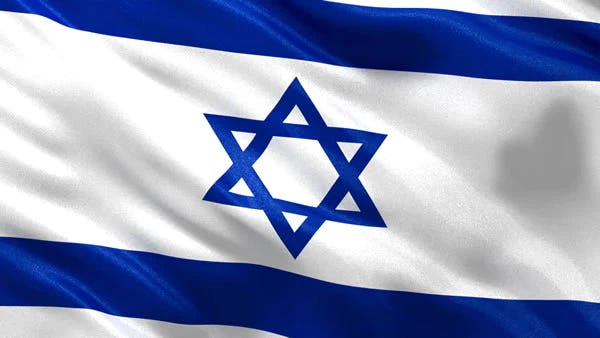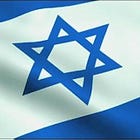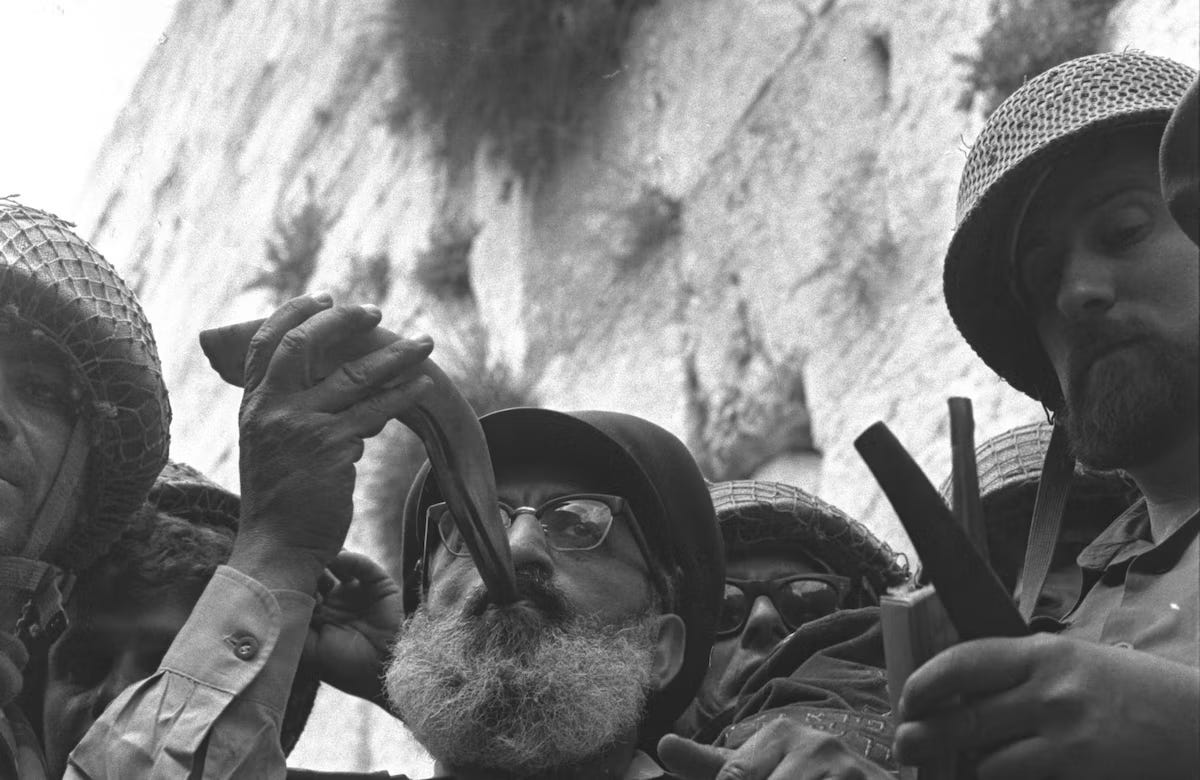In my last post I described the beginning of the Six Day War. Click the link below if you missed it.
Today I will go through the second half of the war and the aftermath of this lopsided Israeli victory.
With the Old City and the Western Wall open before the Israelis, the topic that dominated all discussions inside the Eshkol government was the fate of the Old City, should they capture it or stay away from it? The cabinet was divided on the issue, but were in one of two camps. The first camp, represented by Yigal Allon, Minster of Immigration, believes Israel would become an international pariah and a villain if they conquered the Old City. Haim-Moshe Shapira, Minister of Internal Affairs, on the other hand, represented the idea that it had been a mistake not to take the Old City in 1948 and now they had a chance to rectify history as well as finally bringing the holiest site in all of Judaism back under the control of Jews for the first time in 2,000 years. Eshkol himself, mostly believed the Allon camp was right and it was better not to come anywhere near the Old City but at the same time knew that taking the Old City would be very popular among normal Jewish citizens. And as he always did when there was a hard decision to be made, he let someone else decide for him. In this case, that someone else, was Moshe Dayan, and he was squarely in the Allon camp. Dayan feared that Israel would be subjected to fierce international backlash and the outrage of Christians worldwide if the IDF fought its way into the Old City. He was also very concerned with damage to holy sites and the prospect of having to fight in built-up areas. Therefore, he ordered the IDF not to enter the Old City. Privately, he told David Ben-Gurion that he was also concerned over the prospect of Israel capturing Jerusalem's holy sites, only to be forced to give them up under the threat of international sanctions.
On June 7, when Dayan heard that the UN was about to declare a ceasefire, he changed his mind about taking the Old City and, without any discussions with the rest of the cabinet, ordered the capture the Old City. At 7:30 am, on June 7, General Haim Bar-Lev walked into Narkiss’s forward command post, he had taken a helicopter up from Tel Aviv to announce that the government had authorized the Old City attack to proceed. “You are to take the Old City, but with saichel [sense],” said Bar-Lev. The General Staff did not want heavy casualties or damage to the holy places. General Bar-Lev, the Deputy Chief of Staff, asked the most important question of the day when he said:
“The question is, how do you take the Old City with a minimum of shooting?”
Narkiss had no precise answer. Even though the army had drawers filled with contingency plans for virtually every conceivable target and circumstance, there was none for taking Jerusalem’s Old City, as if this were a sacred act best left to the Messiah. The folder for Jerusalem at Central Command headquarters contained a three-stage plan in the event of war that included a breakthrough to Scopus via Mandelbaum Gate and Sheikh Jarrah; widening the Jerusalem corridor to the north and capturing Abu Tor south of the Old City; and finally capturing the Old City. Although detailed plans existed for the first two stages, there was none for capturing the Old City, not even an indication of which of its seven gates would be penetrated. The contingency plan stipulated that separate orders would be provided for the Old City when the need arose. Although officers had made informal proposals over the years, there was no agreed-upon plan in the files. Unbeknownst to the Israelis almost all the Jordanian garrison of Jerusalem had fled the city before it had been completely cutoff.
Two paratrooper battalions started the assault by attacking Augusta-Victoria Hill, one from Mount Scopus and the other from a valley to the right. Another paratroop battalion, personally led by Mordecai Gur, decided to break into the Old City through the Lion’s Gate. They were joined by the other two battalions but met little resistance. General Narkiss was at his forward command post on Mount Scopus, when he heard Gur on the radio ordering the break-in to the Old City through Lion’s Gate. Narkiss jumped in a jeep with Bar-Lev and set out in that direction. The general could not help recalling his last brief entry into the Old City during the War of Independence 19 years before. Narkiss looked at General Bar-Lev and said “Let’s not go in if it’s just to go out again.” Bar-Lev responded that “We’ll never leave again,.”
The fighting was conducted solely by the paratroopers, there was no armor used during the battle, out of fear of severe damage to the Old City. The first group of paratroopers that reached the Western Wall were overwhelmed by the emotions of 2,000 years of bigotry, violence and murder. It was a scene of unbelievable poignancy. Dirty, exhausted and bloody Israeli paratroopers crying at their holiest place.
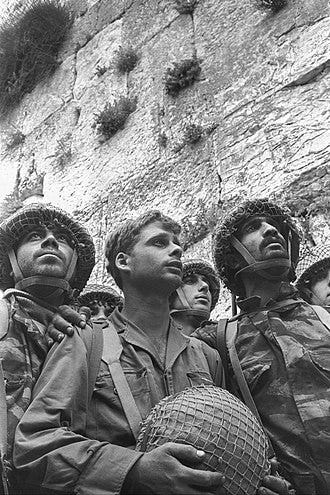
A few minutes later IDF Chief Rabbi Shlomo Goren arrived at the wall with a shofar (a religious horn made from a ram’s horn) and a Torah scroll. He blew the shofar, which had been illegal since 1930 and then announced:
"Israel will never again relinquish the Wall"
After performing the illegal act, Goren was hoisted upon the shoulders of the soldiers. Generals Yitzhak Rabin, Bar-Lev and Narkiss and Colonel Gur, also made the trip to the Western Wall and we're just as moved as the soldiers, overwhelmed by the enormity of what they had accomplished. Rabin described the moment:
"There was one moment in the Six-Day War which symbolized the great victory: that was the moment in which the first paratroopers, under Gur’s command, reached the stones of the Western Wall, feeling the emotion of the place. There never was, and never will be, another moment like it. Nobody staged that moment. Nobody planned it in advance. Nobody prepared it and nobody was prepared for it, it was as if Providence had directed the whole thing: the paratroopers weeping—loudly and in pain—over their comrades who had fallen along the way, the words of the Kaddish prayer heard by Western Wall's stones after 19 years of silence, tears of mourning, shouts of joy, and the singing of Hatikvah” (Israel’s National Anthem).
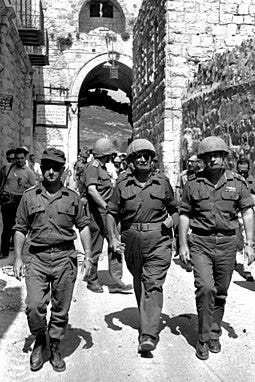
Later, Narkiss ordered the army to dig in on the east side of the Mount of Olives and put out minefields and anti-tank guns to defend against a possible Jordanian counterattack.
Colonel Gur posted guards to keep Israelis from entering the Al-Aksa Mosque or the Dome of the Rock and Dayan ordered that an Israeli flag the first soldiers in the Old City, had raised above the golden dome of the Mosque, be taken down. He would soon decree that control of the Temple Mount be returned to Muslim authorities. Damage to holy places was minimal. The only damage on the Temple Mount was to the door of Al- Aksa Mosque, and a few bullet nicks. Saint Anne's, which is near the Lion's Gate, was the only church to receive substantial damage when several artillery shells hit the roof. Following a visit to Jerusalem immediately after the war, Monsignor Abrahamo Frescht, president of the Pontifical Aid Organization, would report to Rome that damage “was so minimal it hardly seems possible there was a fierce house-to-house fight. Dayan, Rabin, and a few other senior officers returning from the Western Wall joined Narkiss in his command post in the basement of the Jerusalem International Convention Center late Wednesday. They sat on folding cots and a few chairs in the windowless room lit by battery-operated lamps. A radio transmitter crackled in the corner. The men in the room were largely silent as they attempted to absorb the amazing developments of the past 48 hours. It was Rabin who focused the diffused impressions into a stark bottom line, when he said. “How do we control a million Arabs?”, referring to the Arabs of the West Bank and Gaza Strip. “A million, two hundred-fifty thousand,” a staff officer corrected, it was a question Israel would still be asking nearly half a century later.
As the Israelis were recovering from the emotional outpouring in the Old City General Narkiss learned that the 10th Harel Mechanized Brigade, under the command of Uri Ben-Ari was halfway to Jericho. Narkiss ordered him to return to Jerusalem immediately. Later in the day, when Israeli Intelligence intercepted an order from King Hussein calling for the pullback of all forces across the Jordan River, Moshe Dayan ordered the IDF to take the West Bank.
A battalion from General Ugda Peled’s division probed Jordanian defenses in the Jordan Valley, while the 37th Armored Brigade captured the western portion of the West Bank. The 45th Armored Brigade attacked Jordanian artillery positions around Jenin, which had been shelling Ramat David Airbase, however the Jordanian 12th Armored Battalion, held off repeated attempts to capture Jenin. The IDF called in airstrikes which took their toll on the Jordanian M-48 Patton tanks and their external fuel tanks. The 12th Brigade was quickly reduced from 18 tanks to only six and just after dusk Israeli reinforcements arrived. The Jordanians were putting up a valiant fight and the IDF could only advance with continuous artillery and air support. Eventually, the Israelis gained the upper hand and when Jordanian commander was killed, the surviving members of the 12th Armored Brigade withdrew to Jenin, where they were reinforced by the 25th Infantry Brigade. By this time the 12th only had three working tanks and were surrounded inside Jenin. The Jordanian infantry and their three remaining tanks managed to hold off the Israelis until 4:00 am, when three battalions arrived to reinforce them. The Jordanian tanks charged in a nearly suicidal attack but were able to knock out several Israeli vehicles. The Israelis were shocked by the ferociousness of the attack and the tide began to shift. However, after sunrise, Israeli air power, once again weighed in and jets and artillery conducted a two-hour bombardment against the Jordanian positions. The Israelis then fought their way into Jenin and captured the city after fierce fighting.
After the Old City fell, the Jerusalem Brigade joined the paratroopers, and continued the push south, capturing Gush Etzion and Hebron was taken without resistance. Fearful that Israeli soldiers would exact retribution for the 1929 massacre of the city’s Jewish population, Hebron's residents flew white sheets from their windows and rooftops and gave up their weapons. The Harel Brigade proceeded eastward, descending to the Jordan River. On June 7, IDF forces seized Bethlehem, taking the city after a brief battle. On the same day, the 37th Armored Brigade seized Nablus.
The 37th Brigade joined with the 10th Harel Mechanized Brigade and Colonel Gur's 55th Paratroop Brigade to assault Ramallah, while the 45th, 4th and 5th Brigades blocked the Jordan river crossings and the 10th Engineering Corps blew up the Abdullah and Hussein bridges over the river, while elements of the Harel Brigade crossed the river and occupied positions along the east bank to cover them, crossing back into the West Bank when the operation was over. The Jordanians, who anticipating an Israeli offensive driving deep into Jordan, assembled the remnants of their army and Iraqi units in Jordan to protect the western approaches to Amman and the southern slopes of the Golan Heights.
As Israel continued its offensive on June 7, ignoring the recently passed, UN ceasefire resolution. General Riad ordered a full Jordanian withdrawal for a second time, this time to avoid the complete annihilation of the entire Jordanian army. The withdrawal was complete by nightfall on June 7. Never in the wildest dreams of Moshe Dayan, Levi Eshkol and the rest of the Israeli command structure did they ever imagine the war going this way, Uzi Narkiss put it best when he said:
First, the Israeli government had no intention of capturing the West Bank. On the contrary, it was opposed to it. Second, there was not any provocation on the part of the IDF. Third, the rein was only loosened when a real threat to Jerusalem's security emerged. This is truly how things happened on June 5, although it is difficult to believe. The end result was something that no one had planned.
Israel had defeated Egypt and Jordan in turn but their other neighbor, the one who had started the whole mess with their water diversion efforts, had largely stayed out of the war. On the first day they had been hammered just like Egypt and Jordan. On that first day the Syrians lost 32 MiG-21s, 23 MiG-15s and MiG-17s and two IL-28 bombers, two-thirds of their total fighting strength. The surviving aircraft fled to far eastern bases and played no further role in the war.
False Egyptian reports of a crushing victory against the Israeli army, and forecasts that Egyptian forces would soon be attacking Tel Aviv influenced Syria's decision to enter the war.
On June 6, a small Syrian force tried to capture the water plants at Tel Dan, and She'ar Yashuv. These attacks and a broader Syrian offensive quickly failed. Syrian reinforcements were decimated by Israeli air attacks, and several tanks were reported to have sunk in the Jordan River. Other problems included tanks being too wide for bridges in the area, lack of radio communications between tanks and infantry, and units ignoring orders to advance.
The Syrians bombarded Israeli civilian settlements north of the Sea of Galilee causing little damage and few casualties, however, an inaccurate report from a Syrian officer said that as a result of the bombardment that "the enemy appears to have suffered heavy losses and is retreating".
On June 7 and 8, Israeli leadership debated about whether to attack the Golan Heights. Syria had supported pre-war raids that had helped raise tensions and had routinely shelled Israel from the Heights. Some Israeli leaders wanted to see Syria punished. The prevailing military opinion was that the attack would be extremely costly since it would entail an uphill battle against a strongly fortified enemy. The western side of the Golan Heights consists of a rock escarpment that rises 1,700 feet from the Sea of Galilee and the Jordan River, and then flattens to a gently sloping plateau. Dayan opposed the operation bitterly at first, believing such an undertaking would result in losses of 30,000 men and might trigger Soviet intervention. Prime Minister Eshkol, on the other hand, was more open to the possibility, as was the head of the Northern Command, David Elazar, whose unbridled enthusiasm for, and confidence in, the operation may have eroded Dayan's reluctance. Eventually, the situation on the Southern and Central fronts cleared up, intelligence estimated that the likelihood of Soviet intervention had been reduced, reconnaissance showed Syrian defenses in the Golan region collapsing, and an intercepted cable revealed that Nasser was urging the President of Syria to immediately accept a cease-fire. At 3 am on June 9, Syria announced its acceptance of the cease-fire. Despite this announcement, Dayan became more enthusiastic about the idea and at 7 am, gave the order to go into action against Syria without consultation or government authorization.
The Syrian army consisted of about 75,000 men grouped in nine brigades, supported by an adequate amount of artillery. The Golan Heights' unique terrain (mountainous slopes crossed by parallel streams every few miles running east to west), and the general lack of roads in the area channelled forces along east–west axes of movement restricting the ability of units to support those on either flank. Thus the Syrians could move north–south on the plateau itself, and the Israelis could move north–south at the base of the Golan escarpment. An advantage Israel possessed was the excellent intelligence collected by Mossad operative Eli Cohen (who was captured and executed in Syria in 1965) regarding the Syrian battle positions. Syria had built extensive defensive fortifications in depths up to nine miles. While the planning for a Golan operation was ramping up, another incident took place that could have led to a cooling of the relationship between Israel and the United States.
On June 8 1967, The USS Liberty, a United States Navy electronic intelligence vessel sailing 13 nautical miles off Arish (just outside Egypt's territorial waters), was attacked by Israeli jets and torpedo boats, nearly sinking the ship, killing 34 sailors and wounding 171. Israel said the attack was a case of mistaken identity, and that the ship had been misidentified as the Egyptian destroyer El Quseir. Israel apologized for the mistake and paid compensation to the victims or their families, and to the United States for damage to the ship. From the start, the response to Israeli statements of mistaken identity ranged between frank disbelief to unquestioning acceptance within the administration in Washington.
As opposed to all the other campaigns, IAF was only partially effective in the Golan because the fixed fortifications were so effective. However, the Syrian forces proved unable to put up effective defense largely because the officers were poor leaders and treated their soldiers badly; often officers would retreat from danger, leaving their men alone, confused and ineffective. The Israelis also had the upper hand during close combat that took place in the numerous Syrian bunkers along the Golan Heights, as they were armed with the Uzi, a submachine gun designed for close combat, while Syrian soldiers were armed with the AK-47 an assault rifle, designed for combat in more open areas.
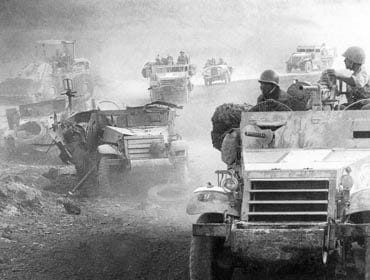
On the morning of June 9, Israeli jets flew dozens of sorties against Syrian positions from Mount Hermon to Tawfiq, using rockets salvaged from captured Egyptian stocks. The airstrikes knocked out artillery batteries and storehouses and forced transport columns off the roads. The Syrians suffered heavy casualties and a drop in morale, with a number of senior officers and troops deserting. The attacks also provided cover for Israeli sappers clearing paths through Syrian minefields. However, the airstrikes did not seriously damage the bunkers and trench systems, and the bulk of Syrian forces remained intact.
About two hours after the airstrikes began, the 8th Armored Brigade, led by Colonel Albert Mandler, advanced into the Golan Heights from Givat Haem. The advance was spearheaded by Engineering Corps sappers and eight bulldozers, clearing away barbed wire and mines as they advanced. While in the minefields, the force came under fire, and five bulldozers were immediately hit. The Israeli tanks, with their maneuverability sharply reduced by the terrain, advanced slowly under fire, toward the fortified village of Sir al-Dib, which stood between them and their objective, the fortress at Qala. Part of the attacking force lost its way and emerged opposite Za'ura, a redoubt manned by Syrian reservists. With the situation critical, Colonel Mandler ordered simultaneous assaults on Za'ura and Qala. Heavy and confused fighting followed, with Israeli and Syrian tanks struggling around obstacles and firing at extremely short ranges. Mandler recalled that "the Syrians fought well and bloodied us. We beat them only by crushing them under our treads and by blasting them with our cannons at very short range.” The first three Israeli tanks to enter Qala were stopped by a Syrian bazooka team, and a relief column of seven Syrian tanks arrived to repel the attackers.
The Israelis took heavy fire from the houses, but could not turn back, as other forces were advancing behind them, and they were on a narrow path with mines on either side. The Israelis continued pressing forward and called for air support. A pair of Israeli jets destroyed two of the Syrian tanks, and the remainder withdrew. The surviving defenders of Qala retreated after their commander was killed. Meanwhile, Za'ura fell and the Israelis also captured the fortress at 'Ein Fit.
In the central sector, the Israeli 181st Battalion captured the strongholds of Dardara and Tel Hillal after fierce fighting. Desperate fighting also broke out along the operation's northern axis, where the Golani Brigade attacked thirteen Syrian positions, including the formidable Tel Fakhr Triangle. Navigational errors placed the Israelis directly under the Syrians' guns and in the fighting that followed, both sides took heavy casualties, with the Israelis losing all nineteen of their tanks and half-tracks. The Israeli battalion commander then ordered his twenty-five remaining men to dismount, divide into two groups, and charge the northern and southern sides of the Triangle. The first troops to reach the perimeter of the southern side, laid on the barbed wire, allowing their comrades to vault over them. From there, they assaulted the fortified Syrian positions. The fighting was waged at extremely close quarters, often hand-to-hand.
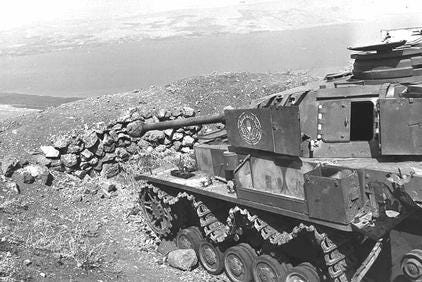
On the northern side, the Israelis broke through within minutes and cleared out the trenches and bunkers. During a seven-hour battle.
By the evening of June 9, the four Israeli brigades had all broken through to the plateau, where they could be reinforced and replaced. Thousands of reinforcements began reaching the front, those tanks and half-tracks that had survived the previous day's fighting were refueled and replenished with ammunition, and the wounded were evacuated. By dawn, the Israelis had eight brigades in the sector.
Syria's first line of defense had been shattered, but the defenses beyond that remained largely intact. Mount Hermon and the Banias in the north, and the entire sector between Tawfiq and the Customs House Road in the south remained in Syrian hands. In a meeting early on the night of June 9, Syrian leaders decided to reinforce those positions as quickly as possible and to maintain a steady barrage on Israeli civilian settlements
Throughout the night, the Israelis continued their advance, though it was slowed by fierce resistance and an anticipated Syrian counterattack never materialized. At the fortified village of Jalabina, a garrison of Syrian reservists, leveled their anti-aircraft guns and held off the Israeli 65th Paratroop Battalion for four hours before a small detachment managed to penetrate the village and knock out the heavy guns.
Meanwhile, the 8th Brigade's tanks moved south from Qala, advancing six miles to Wasit under heavy artillery fire. At the Banias in the north, Syrian mortar batteries opened fire on advancing Israeli forces after Golani Brigade sappers cleared a path through a minefield.
On the next day, June 10, the central and northern groups attacked in a pincer movement but it fell on an empty plateau, because the Syrian forces had retreated. It was not a route, because even as they abandoned their vehicles, they had also burned documents before pulling out. Several Israeli units climbed to the Golan from the south, only to find the positions mostly empty. When the 8th Brigade reached Mansura, five miles away, the Israelis met no opposition and found abandoned equipment, including tanks, in perfect working condition. In the fortified Banias village, the only Syrians the Golani Brigade troops found, had been chained to their positions by their officers. Sadly, to late for the Syrians, they realized that the news it had received from Egypt of the near-total destruction of the Israeli military could not have been true.
In the afternoon of the 10th, Israeli forces consolidated their positions. In some locations, Israeli troops advanced even after an agreed-upon cease-fire, to occupy strategically important positions. These position later became the cease-fire line known as the Purple Line.
In an effort to pressure the United Nations into enforcing a ceasefire, Damascus Radio undercut its own army by broadcasting the fall of the city of Quneitra, three hours before it actually capitulated. That premature report of the surrender of their headquarters destroyed the morale of the Syrian troops left in the Golan area.
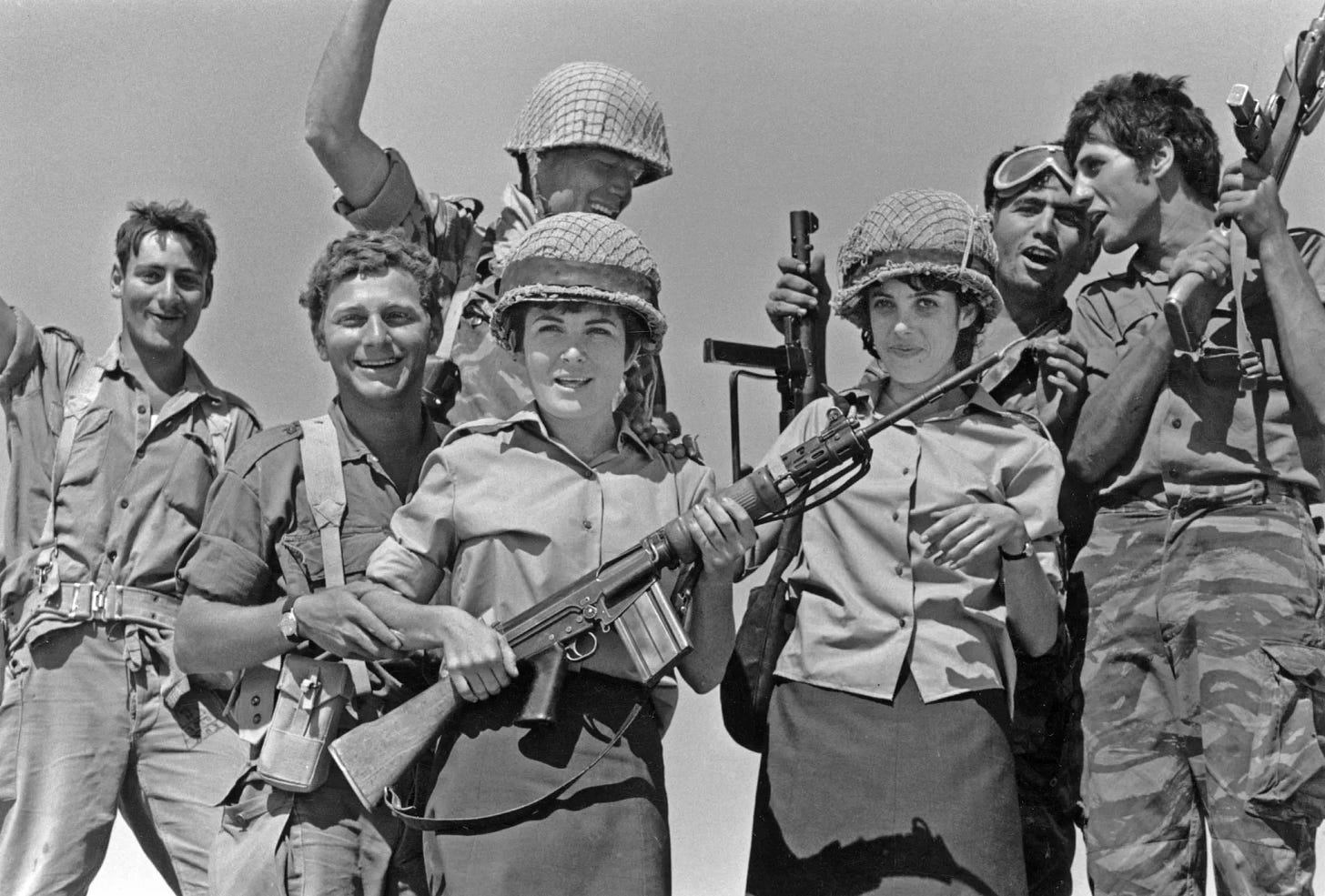
On June 10, a ceasefire was signed, placing one million Arabs under Israel's direct control in the newly captured territories. Israel's strategic depth grew to 190 miles in the south, 40 miles in the east, and 15 miles of extremely rugged terrain in the north, a security asset that would prove useful in the Yom Kippur War six years later.
Speaking three weeks after the war ended, as he accepted an honorary degree from Hebrew University, IDF Chief of Staff, Yitzhak Rabin gave his reasoning behind the overwhelming success of Israeli forces:
“Our airmen, who struck the enemies' planes so accurately that no one in the world understands how it was done and people seek technological explanations or secret weapons; our armored troops who beat the enemy even when their equipment was inferior to his; our soldiers in all other branches, overcame our enemies everywhere, despite the latter's superior numbers and fortifications—all these revealed not only coolness and courage in the battle but an understanding that only their personal stand against the greatest dangers would achieve victory for their country and for their families, and that, if victory was not theirs the alternative was annihilation.”
Dayan's final report on the war to the Israeli general staff listed several shortcomings in Israel's actions, including misinterpretation of Nasser's intentions, overdependence on the United States, and reluctance to act when Egypt closed the Straits. He also credited several factors for Israel's success: Egypt did not appreciate the advantage of striking first and their adversaries did not accurately gauge Israel's strength and its willingness to use it.
In Egypt, Nasser admitted his responsibility for the spectacular defeat. An Egyptian review of the war blamed Nasser's mistaken decisions to expel the international peacekeeping force from the Sinai Peninsula and close the Straits of Tiran, the individualistic bureaucratic leadership and military promotions on the basis of loyalty, not expertise. As well as the army's fear of telling Nasser the truth, a lack of reliable intelligence and a better Israeli command, organization, and will to fight.

The Six Day War left destroyed equipment all over the Sinai Desert, West Bank, Gaza Strip and Jerusalem. The IDF lost 400 tanks and 46 aircraft and Arab forces lost 460 aircraft and 852 tanks. Just like the fighting itself the distribution of the casualties was very lopsided. 983 Israelis were killed and another 4,517 were wounded. Arab casualties were far greater. 15,000 Egyptians were killed or listed as missing in action and 4,338 soldiers were captured. Jordan's losses were 700 killed and 2,500 wounded. Syria suffered 2,500 killed, 6,000 wounded and 591 Syrians were captured. Fifteen UN peacekeepers were killed, 34 US Navy and NSA personal were killed and 271 were wounded. 20 Israeli civilians were killed and 1,200 were wounded.
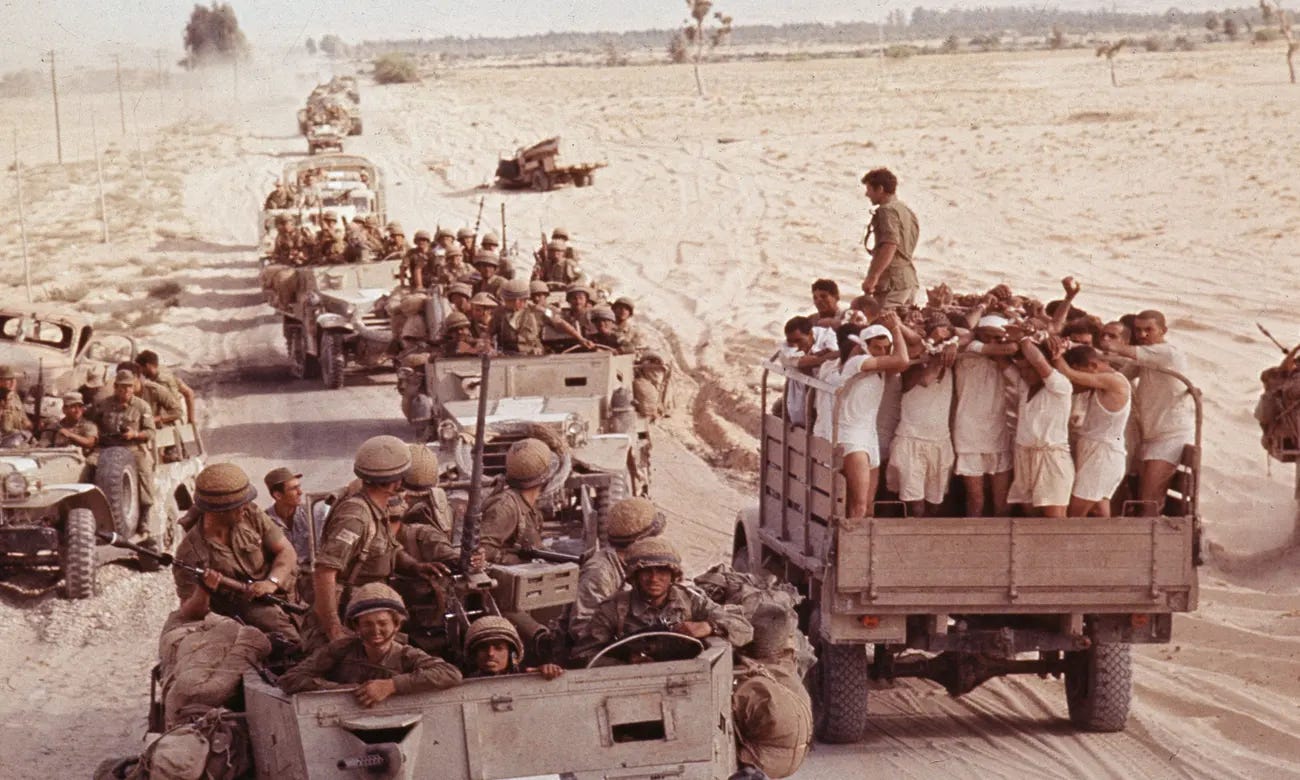
Following the war, lessons were learned by both sides. The Arabs now understood the detriment of a military leadership based on patronage and political security. As well as the importance of telling yourself the truth about what was happening on the ground. They also learned that they needed to close the gap between, the military technology of Israel and there own. The Egyptians took these lessons to heart and six years later, would use them to shock Israel in the Yom Kippur War.
The lessons Israel learned were much different, they learned that the Arab armies were inferior to theirs in every way except size. They learned that air power was their saving grace and could change the outcome of both a single battle and an entire war. These lessons would not serve them well in the upcoming years as the grew arrogant and overconfident, believing that the next war would just be a repeat of the last. On a positive note however, the Israelis identified many of their future leaders in the conflict including:
Yitzhak Rabin (Chief of the General Staff): Held many posts in multiple Israeli governments, including Minister of Defense and would also become Prime Minister.
Ariel Sharon (38th Division Commander): Would enter government in 1968 and stay there until his death. He would hold positions from the Ambassador to the United States to, two terms as Prime Minister.
Mordechai Gur (55th Paratrooper Brigade Commander): Would be elected to the Knesset and held several ministerial posts in multiple governments.
Rafael Eitan (202nd Paratrooper Brigade commander): Would also be elected to the Knesset and would be Minister of Agriculture in two different governments
Aharon Yariv (Head of IDF military Intelligence): Would be elected to the Knesset and hold several ministerial posts.
Ezer Weizman (Deputy Chief of the General Staff): Would be elected to the Knesset and hold several ministerial posts.
Israel experienced a wave of national euphoria, the press praised the military's performance for weeks afterwards. The world's interest in Israel grew, and the country's economy, which had been in a recession before the war, flourished due to an influx of tourists and donations. The aftermath of the war also saw a baby boom, which lasted for four years.
There was also a huge religious significance to the 1967 victory. Jordan had been the lawful authority in East Jerusalem and the Old City since 1948. Under Jordanian rules, Jews had been expelled from East Jerusalem, effectively barring them from visiting the Western Wall, despite the fact that Article VIII of the 1949 Armistice Agreement, specifically stated that there would be unfettered access to the Western Wall. Other Jewish holy sites were not maintained, and Jewish cemeteries had been desecrated. After June of 1967, each religious group was granted administration over their own holy sites.
According to the Bible, the Temple of Solomon was built on Mount Moriah, (the place Abraham was going to sacrifice Jacob), in the year 957 BC. It was destroyed by King Nebuchadnezzar II in 587 BC. The Second Temple was built by King Zerubbabel, (the Jewish King during their return from exile in Babylon), in 516 BC, refurbished by King Herod from 25 BC to 18 BC and destroyed by the Romans in 70 AD. Muslims conquered Jerusalem in 653 AD and built the Dome of the Rock (marking the place where Mohamed ascended to Heaven,(also the same rock Abraham was going to use as an alter for Jacob), in 692 with the al-Aqsa mosque coming in 715 AD and since then, Jews have been restricted in one way or another from worshipping at the only remaining part of the Second Temple, the Western Wall. After World War I the British were in charge but maintained the prevailing policy of restricting Jews from the Western Wall and since 1948, the Temple Mount had been under the sole administration of the Jordanian Muslim Waqf, and Jews are barred from praying there, although they were allowed to visit it. However, after the Six Day War and for the first time since 1948, Jews could visit the Old City of Jerusalem and pray at the Western Wall, an event celebrated every year during Yom Yerushalayim.
In Hebron, Jews gained access to the Cave of the Patriarchs, the second holiest site in Judaism, for the first time since the 14th century. Other Jewish holy sites, such as Rachel's Tomb in Bethlehem and Joseph's Tomb in Nablus, also became accessible.
The war inspired the Jewish diaspora to return to Israel. Thousands of Jewish immigrants arrived from Western countries such as the United States, United Kingdom, Canada, France and South Africa after the war. Jewish immigration from Western countries, which was previously only a trickle, was a significant force for the first time.
In the Arab nations, minority populations of Jews faced persecution and expulsion following the Israeli victory. Mobs attacked Jewish neighborhoods in Egypt, Yemen, Lebanon, Tunisia, and Morocco, burning synagogues and assaulting residents. A pogrom in Tripoli, Libya, left 18 Jews dead and 25 injured, with the survivors herded into detention centers. Of Egypt's 4,000 Jews, 800 were arrested, including the chief rabbis of both Cairo and Alexandria, and their property seized by the government. The ancient Jewish communities of Damascus and Baghdad were placed under house arrest, their leaders imprisoned and fined. A total of 7,000 Jews were expelled, many with just one bag. All of this contributing to the Jewish exodus from Arab lands, which had been ongoing since 1948. As a result, Jewish populations in Arab countries further diminished as many Jews emigrated to Israel and other Western countries.
The Six Day War was one of the most one-sided victory in military history and set up Israel, for future failure and 50+ years of violence, terrorism, distrust and hate. I hope you have enjoyed this post and this series overall. The next post will combine the next six years in Israeli history and the build-up to the Yom Kippur War. I hope you are enjoying this series and look forward to reading them as much as I look forward to writing them.




